A Suit of Hearts – Ganjifa Playing Cards
PRIMITIVE - Friday, May 22, 2015By Misaki Imagawa
Edited by Glen Joffe
Editor’s Note: Recently, PRIMITIVE acquired a collection of Ganjifa playing cards from India. Ganjifa cards are traditional hand painted cards used in a game that became popular under the Mughal emperors in the 16th century. I can’t say that anyone here really knows how to play Ganjifa, but that hardly matters because the cards have value as art. Each card is a beautifully executed miniature painting depicting scenes that somehow relate to the game. They are inspiring, engaging, and collectible.
The cards were wrapped in tattered pages thinner than newsprint and scarcely visible. Time and conditions had played havoc with the ink and paper. Our restoration department was able to make the script visible with some concoction made known by Sherlock Holmes using lemon juice and vinegar. You might call it salad dressing with a purpose. Even though the dressing worked, it only worked for a short while before the paper dissolved and the script disappeared forever. Luckily, Misaki, our content writer was there to transcribe the words. She noted that even with the application of the dressing she could not see most of what was there. “Fill in the blanks,” I said. “It’s still a compelling story!” We made out the name of the author, Sir Thomas Halford, and gave his story a title. We call it, 'A Suit of Hearts.'
September, 1854.
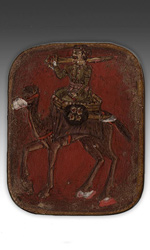 |
|
I write this in the wake of a question posed by my grandson just this evening before tea. The family was gathered in the drawing room where a fire had been lit to ward off an early autumn chill. I was resting on a chaise when Edward approached. The boy had recently discovered an old box of cards and other memorabilia from my younger years in India, and has since acquired a keen interest in my time there. He has been most relentless in stirring up my old memories and I find myself happily regaling him with stories of my youth. My wife, Juhi, his grandmother, often sits with us. It has become a favorite pastime of mine to see her dark beautiful eyes reflected in Edward’s.
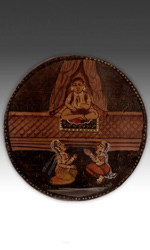 |
|
I have told Edward of my own humble beginnings in the city of Calcutta, born to an Indian mother and a British army officer. When I reached twelve years of age, my father shipped me off to school in England where I spent years fighting off upperclassmen who thought they could ridicule my upbringing and darker complexion. These details were of course trimmed from my narrative to Edward. When I became of age to join the army, I bought a commission and sailed back to India. It is this period of my life – namely my life in the army and all its skirmishes – which Edward has been most curious about. Yet, tonight he asked how I met Juhi.
I was happy to tell him the tale, for the thought alone had me chuckling with merriment. I beckoned Juhi over, and when she settled in I told Edward that I had won her fair and square, in a gamble! My wife, of course, objected, but she did so with laughter and humor. Our grandson, on the other hand, looked absolutely bewildered, even horrified; so Juhi began the story. She was born the royal daughter of the Nawab, or ruling prince, of Savanur State. Her mother was the Nawab’s youngest wife; and Juhi, with many half brothers and sisters older than her, was often left to her own devices when growing up. In 1811, before Savanur became a British protectorate, I was sent as an envoy to establish relations with the Nawab following the end of their occupation by the southern Kingdom of Mysore.
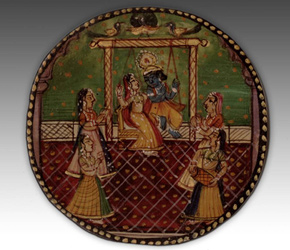 |
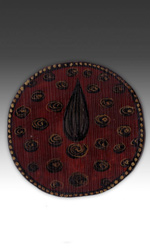 |
||
PRIMITIVE ID# A1000-236 |
|||
I spent several weeks in Savanur under the hospitality of the Nawab and during this time I met Juhi. We became infatuated with each other rather quickly and when my stay in Savanur came to an end, I presented the Nawab with a certain proposition. You see, in my time at court I had noticed the nobles’ love of Ganjifa card games. It came as no surprise, for the Mysore were avid players of this ancient game. I was also familiar with the game, for my maternal grandfather taught me all that he knew about Ganjifa in my early years. He would be proud to know his knowledge served me very well in life. I have rarely lost a game here or in India.
I should point out that Ganjifa cards differ greatly from those played in Britain and Europe. The Ganjifa are not thin and flimsy like the cards here; but instead, are true works of art. Most are round in shape, though some are rectangular. The Ganjifa used by nobles, such as those in Savanur, were made of exquisite materials: stones with inlaid ivory, tortoise shells, mother of pearls, even some from animal bones. They were lavishly decorated with hand painted pictures. Even common-made cards, like the ones my grandfather used, were sturdily made with paper, textile fabric or palm leaves and painted brilliantly with natural pigments.
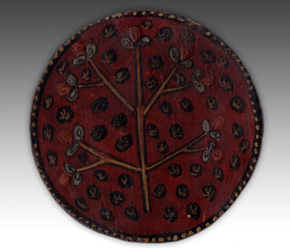 |
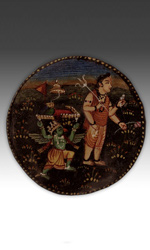 |
||
PRIMITIVE ID# A1000-236 |
|||
The exact origins of Ganjifa cards are unclear; however, it is widely believed they were brought into India by the Mughal Empire in the 16th century. I was told the Persian word ‘ganj’ means ‘treasure’ or ‘treasury.’ The original Mughal Ganjifa has eight suits of twelve cards. The Dashavatara Ganjifa, which was adapted to Hindu culture, contains ten suits of twelve cards each related to the god Vishnu. An intriguing fact is that in each set there is always one suit named after a local coin. The rules of Ganjifa are almost beyond explanation. For example, a suit can become weaker or stronger depending on the time of day or the weather! Suffice to say, the rules are complicated; however, as I learned through my grandfather – beyond being superb entertainment – Ganjifa is both educational and even religious driven. The game taught me about the ancient scriptures and many stories within the holy books. My grandfather and his friends even believed that by playing the game and chanting Vishnu’s names, they were cleansing themselves of all sins.
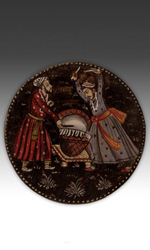 |
|
an Indian Ganjifa playing card; PRIMITIVE ID# A1000-232 |
So, during my last days in Savanur I proposed to the Nawab a game of Ganjifa with highly unusual stakes. If I won, I would take Juhi as my wife. If I lost, my life belonged to the prince to do with as he pleased. I am sure he was already planning my slow and painful death as I made the offer, for the prince was quite prideful and confident. Perhaps that was why he accepted. The day of the game we drew quite a crowd in the court. All sorts of people were gathered around the game table in the central parlor, and even the balconies overhead were crowded with onlookers. The game started slow, but soon my grandfather’s meticulous teachings were put to good use. His knowledge, coupled with my memory – a gift from my parents – along with a little good luck, led me to victory.
The Nawab was not too happy, needless to say. Juhi and I fled Savanur immediately. Later, I was berated for compromising the envoy’s mission in the name of love. However, my wife reached out to her father and in 1818, Savanur became a British protectorate, a development I believe was good for everyone concerned. In gratitude, the prince sent me a pack of highly valuable Ganjifa cards, the very same ones Edward found the other day; but he warned me to never show my face in Savanur again. That suited me perfectly. Juhi was mine and that was all that mattered – though as she often reminds me, my heart was hers long before I won the game of Ganjifa with a hand of straight hearts.
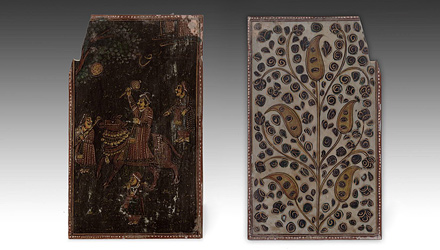 |
Download this Article: A Suit of Hearts - Ganjifa Playing Cards.pdf